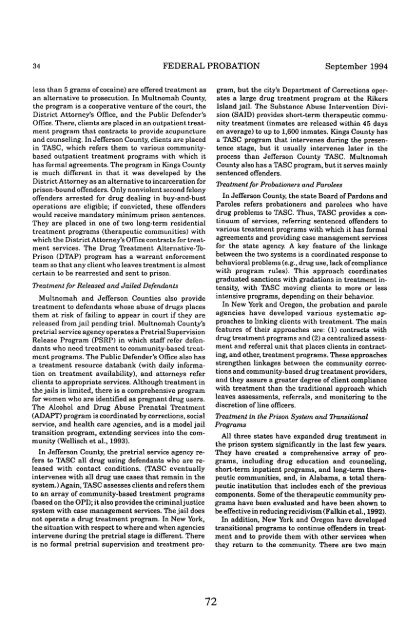9 ~,~i - National Criminal Justice Reference Service
9 ~,~i - National Criminal Justice Reference Service
9 ~,~i - National Criminal Justice Reference Service
Create successful ePaper yourself
Turn your PDF publications into a flip-book with our unique Google optimized e-Paper software.
34 FEDERAL PROBATION September 1994<br />
less than 5 grams of cocaine) are offered treatment as<br />
an alternative to prosecution. In Multnomah County,<br />
the program is a cooperative venture of the court, the<br />
District Attorney's Office, and the Public Defender's<br />
Office. There, clients are placed in an outpatient treatment<br />
program that contracts to provide acupuncture<br />
and counseling. In Jefferson County, clients are placed<br />
in TASC, which refers them to various communitybased<br />
outpatient treatment programs with which it<br />
has formal agreements. The program in Kings County<br />
is much different in that it was developed by the<br />
District Attorney as an alternative to incarceration for<br />
prison-bound offenders. Only nonviolent second felony<br />
offenders arrested for drug dealing in buy-and-bust<br />
operations are eligible; if convicted, these offenders<br />
would receive mandatory minimum prison sentences.<br />
They are placed in one of two long-term residential<br />
treatment programs (therapeutic communities) with<br />
which the District Attorney's Office contracts for treatment<br />
services. The Drug Treatment Alternative-To-<br />
Prison (DTAP) program has a warrant enforcement<br />
team so that any client who leaves treatment is almost<br />
certain to be rearrested and sent to prison.<br />
Treatment for Released and Jailed Defendants<br />
Multnomah and Jefferson Counties also provide<br />
treatment to defendants whose abuse of drugs places<br />
them at risk of failing to appear in court if they are<br />
released from jail pending trial. Multnomah County's<br />
pretrial service agency operates a Pretrial Supervision<br />
Release Program (PSRP) in which staff refer defendants<br />
who need treatment to community-based treatment<br />
programs. The Public Defender's Office also has<br />
a treatment resource databank (with daily information<br />
on treatment availability), and attorneys refer<br />
clients to appropriate services. Although treatment in<br />
the jails is limited, there is a comprehensive program<br />
for women who are identified as pregnant drug users.<br />
The Alcohol and Drug Abuse Prenatal Treatment<br />
(ADAPT) program is coordinated by corrections, social<br />
service, and health care agencies, and is a model jail<br />
transition program, extending services into the community<br />
(Wellisch et al., 1993).<br />
In Jefferson County, the pretrial service agency refers<br />
to TASC all drug using defendants who are released<br />
with contact conditions. (TASC eventually<br />
intervenes with all drug use cases that remain in the<br />
system.) Again, TASC assesses clients and refers them<br />
to an array of community-based treatment programs<br />
(based on the OPI); it also provides the criminal justice<br />
system with case management services. The jail does<br />
not operate a drug treatment program. In New York,<br />
the situation with respect to where and when agencies<br />
intervene during the pretrial stage is different. There<br />
is no formal pretrial supervision and treatment pro-<br />
gram, but the city's Department of Corrections operates<br />
a large drug treatment program at the Rikers<br />
Island jail. The Substance Abuse Intervention Division<br />
(SAID) provides short-term therapeutic community<br />
treatment {inmates are released within 45 days<br />
on average) to up to 1,600 inmates. Kings County has<br />
a TASC program that intervenes during the presentence<br />
stage, but it usually intervenes later in the<br />
process than Jefferson County TASC. Multnomah<br />
County also has a TASC program, but it serves mainly<br />
sentenced offenders.<br />
Treatment for Probationers and Parolees<br />
In Jefferson County, the state Board of Pardons and<br />
Paroles refers probationers and parolees who have<br />
drug problems to TASC. Thus, TASC provides a continuum<br />
of services, referring sentenced offenders to<br />
various treatment programs with which it has formal<br />
agreements and providing case management services<br />
for the state agency. A key feature of the linkage<br />
between the two systems is a coordinated response to<br />
behavioral problems (e.g., drug use, lack of compliance<br />
with program rules). This approach coordinates<br />
graduated sanctions with gradations in treatment intensity,<br />
with TASC moving clients to more or less<br />
intensive programs, depending on their behavior.<br />
In New York and Oregon, the probation and parole<br />
agencies have developed various systematic approaches<br />
to linking clients with treatment. The main<br />
features of their approaches are: (1) contracts with<br />
drug treatment programs and (2) a centralized assessment<br />
and referral unit that places clients in contracting,<br />
and other, treatment programs. These approaches<br />
strengthen linkages between the community corrections<br />
and community-based drug treatment providers,<br />
and they assure a greater degree of client compliance<br />
with treatment than the traditional approach which<br />
leaves assessments, referrals, and monitoring to the<br />
discretion of line officers.<br />
Treatment in the Prison System and Transitional<br />
Programs<br />
All three states have expanded drug treatment in<br />
the prison system significantly in the last few years.<br />
They have created a comprehensive array of programs,<br />
including drug education and counseling,<br />
short-term inpatient programs, and long-term therapeutic<br />
communities, and, in Alabama, a total therapeutic<br />
institution that includes each of the previous<br />
components. Some of the therapeutic community programs<br />
have been evaluated and have been shown to<br />
be effective in reducing recidivism (Falkin et al., 1992).<br />
In addition, New York and Oregon have developed<br />
transitional programs to continue offenders in treatment<br />
and to provide them with other services when<br />
they return to the community. There are two main<br />
72
















